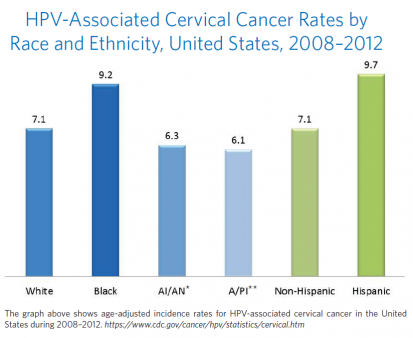Every year in the united states, approximately 12,000 women get cervical cancer and almost 4,000 women die from it. It is the most preventable female cancer with regular screening tests and early treatment.
Cervical cancer is the leading cause of death in women in the United States.2

According to the CDC, for every 100,000 cases of cervical cancer, approximately 9 black women, 7 white women, 6 American Indian/Alaska Native women, and 6 Asian/Pacific Islander women were diagnosed with HPV-associated cervical cancer. Approximately 10 Hispanic women were diagnosed with HPV-associated cervical cancer per 100,000 women, compared to 7 non-Hispanic women.2
Cervical cancer is the leading cause of death in women in the United States.1

There are more than 100 types of HPV, and at least 13 high-risk types have been linked to cancer of the cervix. While most women who develop cervical cancer have HPV, only a small proportion of women infected with HPV develop cervical cancer. HPV types 16 and 18 cause 70% of cervical cancers and precancerous cervical lesions.4
Co-testing is the best cervical cancer screening for women ages 30 to 65
- Published data show that co-testing offers the best protection versus HPV-only, Pap-only, and reflex testing5-7
- Current cervical cancer screening guidelines all recommend co-testing as the preferred screening method for women ages 30 to 658-10†
Reflex testing is not the same as co-testing
Co-testing had the fewest missed cases of cervical cancers than HPV or Pap testing alone5

American College of Obstetricians and Gynecologists (ACOG) guidelines11 for cervical cancer testing using Pap screening
- Most women should be screened for the first time at the age of 21.
- Most women younger than 30 should undergo cervical screening once every two years.
- Women age 30 and older can be re-screened once every three years.
These guidelines are for healthy women. Different screening schedules are recommended for women who have experienced abnormal Pap tests or other health conditions that may put them at greater risk for cervical cancer.
Aptima HPV and Aptima 16,18/45 Genotyping11

References:
- This study used cancer registry data to estimate the amount of HPV-associated cancer in the United States by examining cancer in parts of the body and cancer cell types that are more likely to be caused by HPV. Cancer registries do not collect data on the presence or absence of HPV in cancer tissue at the time of diagnosis.
- HPV-associated cancers were defined as cancers at specific anatomic sites and with specific cellular types in which HPV DNA frequently is found. All cancers were confirmed histologically. Cervical cancers (ICD-O-3 site codes C53.0–C53.9) were limited to carcinomas (ICD-O-3 histology codes 8010–8671, 8940–8941). https://www.cdc.gov/cancer/hpv/statistics/state/cervical.htm
- Regionally area based on U. S. Census Bureau https://www2.census.gov/geo/pdfs/maps-data/maps/reference/us_regdiv.pdf
- http://www.who.int/mediacentre/factsheets/fs380/en/
- Blatt AJ, Kennedy R, Luff RD, et al. Comparison of cervical cancer screening results among 256,648 women in multiple clinical practices. Cancer Cytopathol. 2015;123(5):282-288.
- Quest Diagnostics. Data on file. 2015.
- Mayrand MH, Duarte-Franco E, Rodrigues I, et al. Human papillomavirus DNA versus papanicolaou screening tests for cervical cancer. N Engl J Med. 2007;357:1579-88.
- Saslow D, Solomon D, Lawson HW, et al. American Cancer Society, American Society for Colposcopy and Cervical Pathology, and American Society for Clinical Pathology screening guidelines for the prevention and early detection of cervical cancer. CA Cancer J Clin. 2012;62(3):147-172.
- US Preventive Services Task Force. Final Update Summary: Cervical Cancer: Screening. http://www.uspreventiveservicestaskforce.org/Page/Document/UpdateSummaryFinal/
cervicalcancer-screening. Accessed November 16, 2015. - The American College of Obstetricians and Gynecologists. Practice bulletin 131: Screening for cervical cancer. Obstet Gynecol. 2012;120(5):1222-1238.
- Retrieved from https://www.cdc.gov/cancer/cervical/pdf/HPV_Testing_2012_English.pdf
Diagnostic Laboratory of Oklahoma (DLO) strives to empower patients to take a more active role in their healthcare decisions through providing education on disease states and available diagnostic testing, as well as resources for additional information from medical organizations.





CLIA